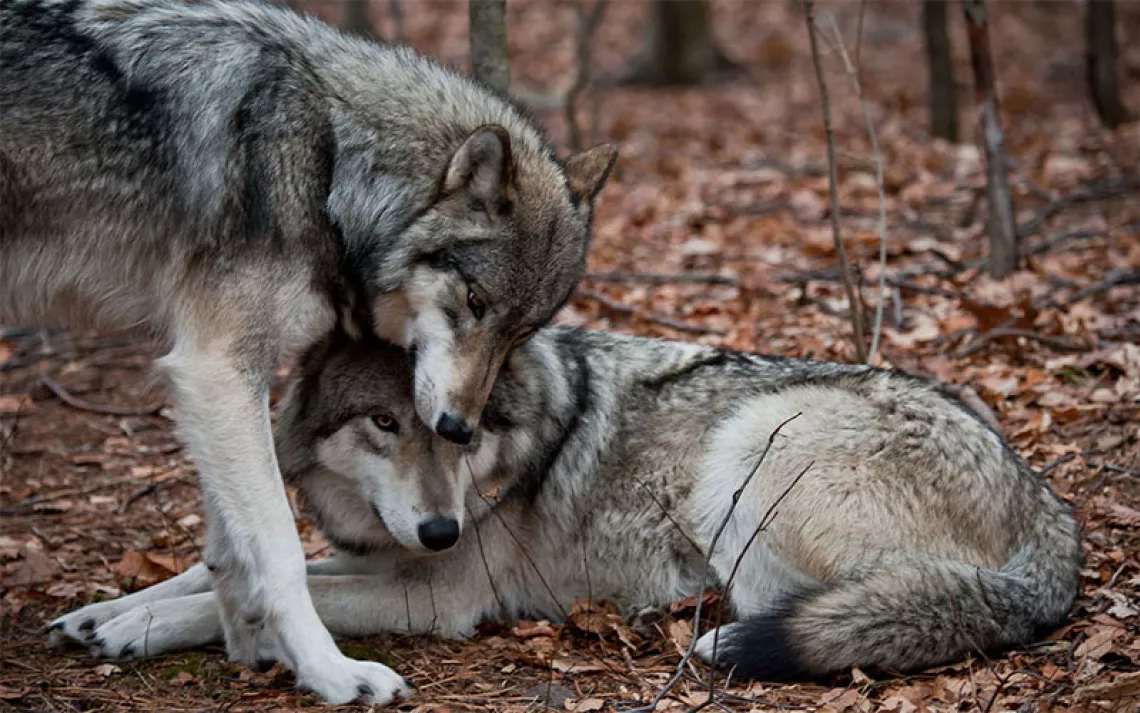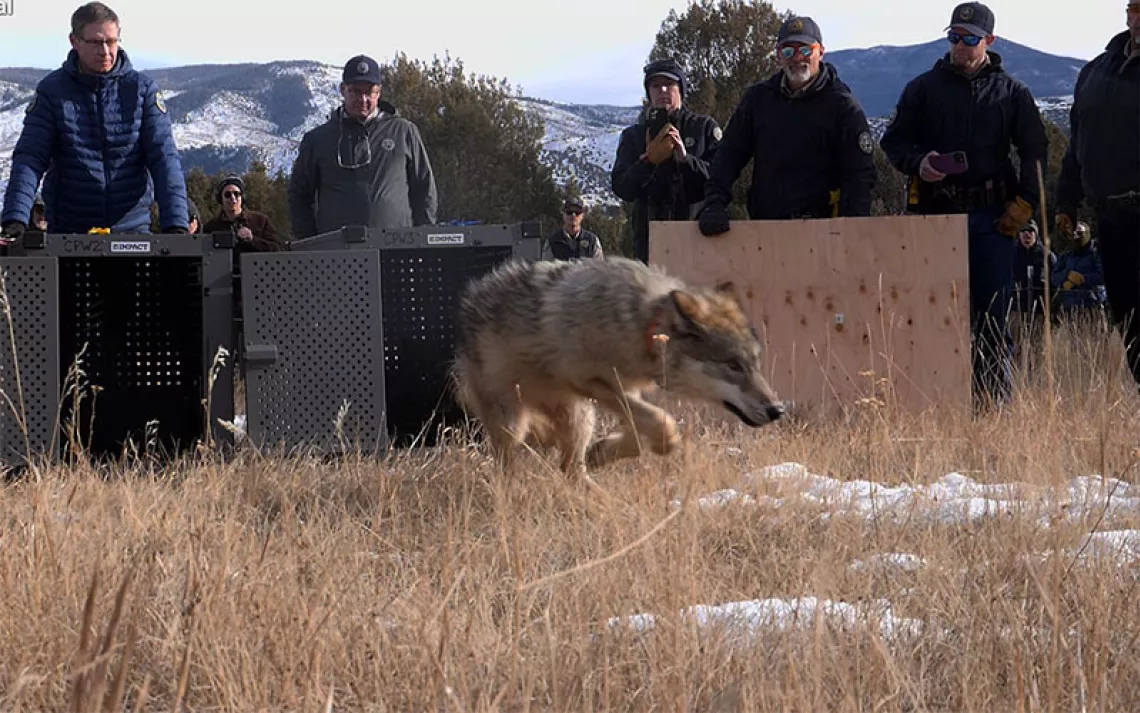The Legacy of OR-7
How a lone gray wolf captured our attention and changed the course of wolf conservation

Photos courtesy of USFWS
OR-7, the Oregon wolf who inspired books and movies, an art contest, an expedition, editorial cartoons, and even a grassroots campaign pushing him for president, is presumed dead. There isn’t a wolf carcass to point to. Nor are there any clues as to his fate, other than this: OR-7 wasn’t seen in the last wolf count, or in any trail camera videos since October, although other members of his pack made appearances. Meanwhile—and this is big—OR-7’s mate was seen in the company of another male.
The crusty old guy was likely pushed out by a new alpha and couldn’t make it on his own. It’s the way these things tend to go, biologists say.
At age 11, he’d already outlived his life expectancy by about 50 percent. Who knows how long he would have lasted if he hadn’t become the poster pup for wolf conservation.
If you’re a wolf lover, this news may hit hard. But in an era when advocates for wild places can feel like they’re under siege, even OR-7’s demise offers some lessons. OR-7’s story stretches through biology, history, policy, ecology, and, ultimately, species’ recovery. It also says something about humans.
OR-7 broke off from his pack of gray wolves in the far northeastern reaches of Oregon in 2011, when he was around two years old. If wolves bothered with gossip, this would have rated a mere yawn. Dispersing from a pack is ordinary wolf behavior—the wolf equivalent of, say, moving out of Mom and Dad’s house. Radio-collar signals showed him heading southwest.
Blip, he was in the Blue Mountains.
Blip, he had crossed the high desert.
Blip, he was in the Cascade Range.
For advocates, it was cool that a wolf was venturing into territory that hadn’t seen a wolf since 1947. With bounties on their carcasses, the wolves had been hunted until there were none to be found.
But, as OR-7 racked up the miles, advocates had their doubts. There was the issue of finding food, and there were poachers. Also, how many highways can a wolf cross before becoming roadkill?
Another inconvenient fact was this lone wolf needed a mate, yet he was walking away from all other known wolves. There were only about two dozen in Oregon at the time, all clustered in the northeast; others were in Idaho and beyond. And yet, blip, here he was, all the way down on the state’s southern border, in Klamath Falls.
It was instinct, or maybe even chance, that led OR-7 southwest. It was a calculated effort that put him in the public’s eye. This wasn’t the farthest any wolf had traveled. OR-7 was just doing what wolves do. There weren’t even any photos of him in these early days. Yet the folks at the conservation group Oregon Wild had an idea. Maybe it was time to alert the media.
“I don’t want to sound overly cynical, I guess, but we’re a 45-year-old conservation organization with a media shop,” explained conservation director Steve Pedery. “We sat around thinking, ‘How are we going to get people to pay attention?’ There was a bit of crass calculation.”
Something about this very uncertain story, they thought, would resonate beyond the usual suspects of conservation groups. As it turned out, the farther OR-7 traveled, the more fascinated people became. At the farthest reaches of his journey, in 2012, he made it to California. It seemed for a while that he would die alone.
“Looking for Love in Wrong Places,” a southern Oregon paper said.
“Wolf Finds Fame in Lone Trek for Love,” read a headline in South Carolina.
And who could forget “Die Liebespirsch des Einsamen Wolfs”?
Yes, the story of a wolf doing little more than acting like a wolf had reached Germany. And Argentina and Australia and Finland. And the reporters kept calling. Oregon Wild launched a naming competition and an art contest for kids. In the relatively early days of social media, it helped make OR-7 a star. Without photos, he was a blank canvas for the imagination.
Several organizations put together a map showing OR-7’s route, which, in turn, allowed them to call attention to other issues that had heretofore gotten little traction. For example, when OR-7 passed through the Klamath Basin, they talked about wildlife refuges there.
Soon, OR-7 was generating his own PR, without help from advocates.
The turnaround was head-spinning.
“It went from desperately trying to get the public to pay attention to something you’re interested in to reacting to people demanding information from you,” Pedery said. “It’s like the ultimate fantasy if you’re an environmental advocate.”

The timing was right. In OR-7’s early days, there were debates in the Oregon state legislature over wolves. The federal government had decided that gray wolves no longer warranted protection under the Endangered Species Act in certain areas, including eastern Oregon. That opened the door for the lethal removal of more wolves accused of killing livestock. In fact, OR-7’s kin were under that threat shortly after his departure.
“When this started, there weren’t kids downloading OR-7 coloring books and following his progress on a map in biology class,” Pedery said. “There were ranchers demanding wolf packs be killed, environmental groups suing to stop it, and wildlife managers agreeing to partial pack removal as the compromise.”
As ranchers and their allies seemed to be gaining momentum, the public fascination with OR-7 became a counterweight.
“It changed the calculus a little bit,” Pedery said. “It got harder to kill these animals not because somebody was going to sue them but because the governor didn’t want to have to answer the question from a reporter at his next press conference.”
John Stephenson, a US Fish and Wildlife biologist who studies Oregon’s wolf population, doesn’t disagree. “I’m sure that’s a consideration. Because he was such a famous wolf.”
This wolf, doing what wolves do, seemed to hold influence over even the politicians.

Sometime in 2014, OR-7 found a mate and settled down in the southern Cascade Range.
They had at least three litters of pups. When Stephenson managed to get a photo of one litter, the internet went crazy. Over time, OR-7’s pups dispersed and formed new packs.
For wolf recovery, “he’s definitely made a mark,” Stephenson said. Today, there are at least 150 wolves in Oregon, spread across 11 counties.
But lately, OR-7’s pack has not done very well in the PR department. Between 2018 and 2019, it was pinned with 18 livestock deaths, more than any other in the state. While wolves are responsible for only a small portion of livestock deaths, ranchers, understandably, become angry with any depredation and continue to call for fewer protections. At the same time, there has been a concerted effort to get creative with nonlethal solutions to the problem. Ranchers, conservationists, and government officials have worked together in OR-7’s territory to do just that.
Without OR-7, Pedery said, “we’d be in a very different place on wolf recovery.” To him, it’s a story of wolf recovery, but also human redemption. Humans, after all, were the ones who decimated the wolf population.
“In my career as an advocate for critters in wild places, it’s always going to be one of our proudest achievements that we had this idea of like, maybe we should do some press on this because that’ll help wolves,” he said. As Pedery well knows, “the public’s fascination with the wild is really what decides what gets protected and what doesn’t.”
 The Magazine of The Sierra Club
The Magazine of The Sierra Club



